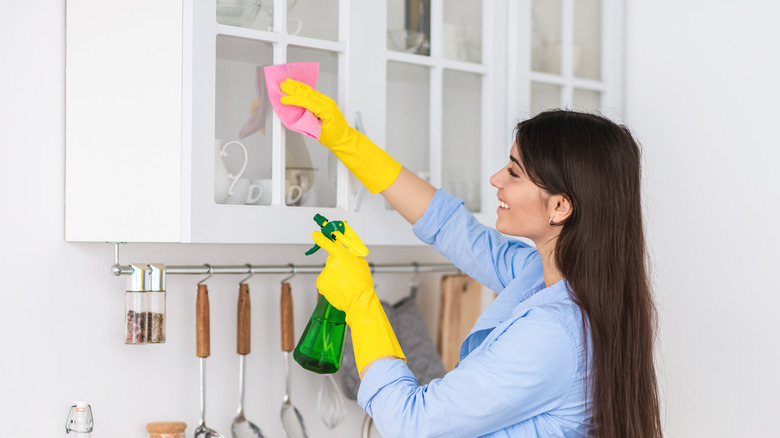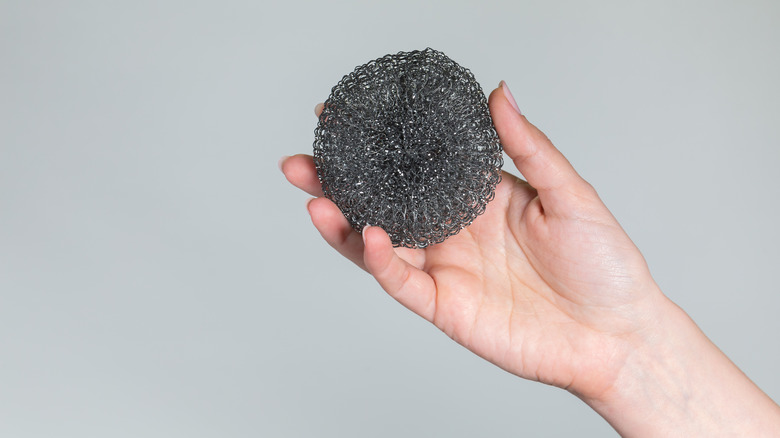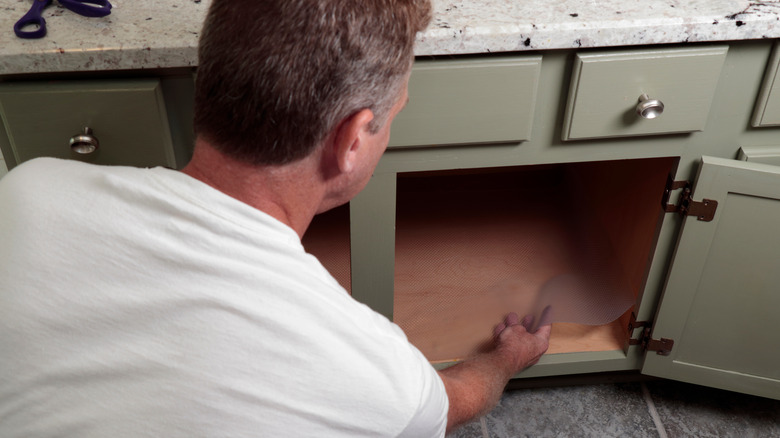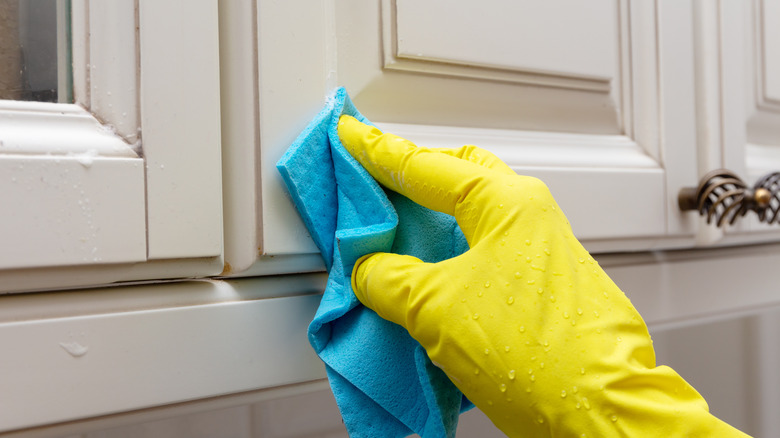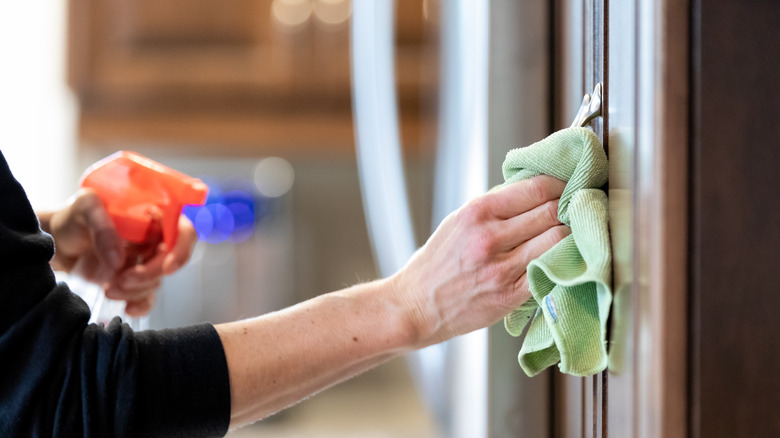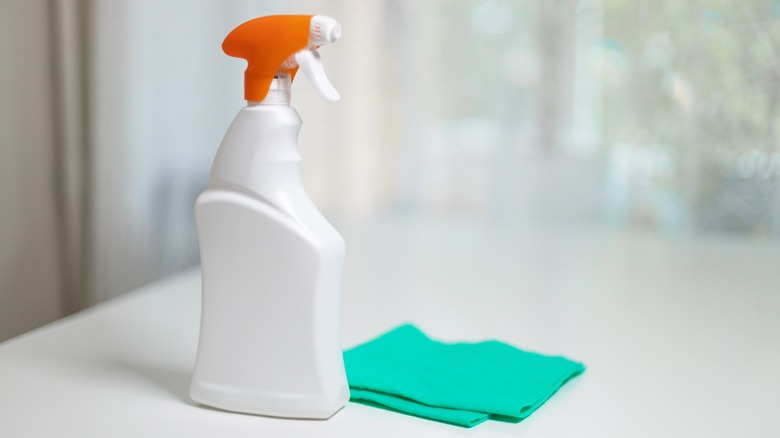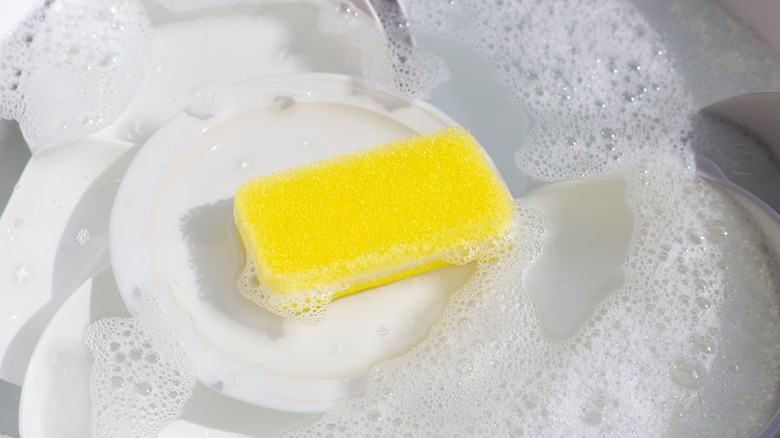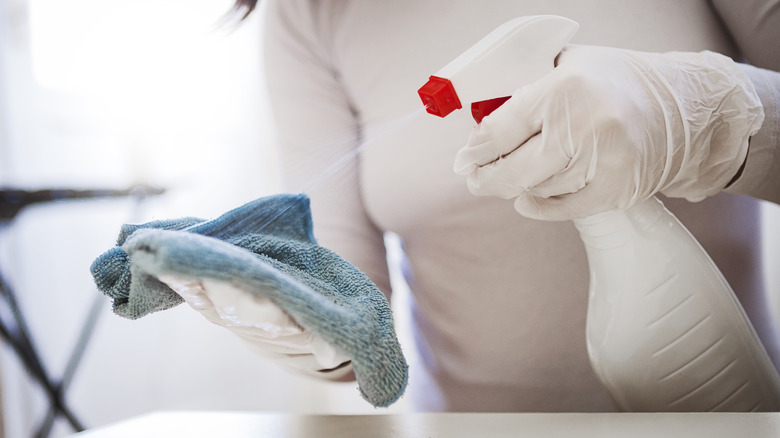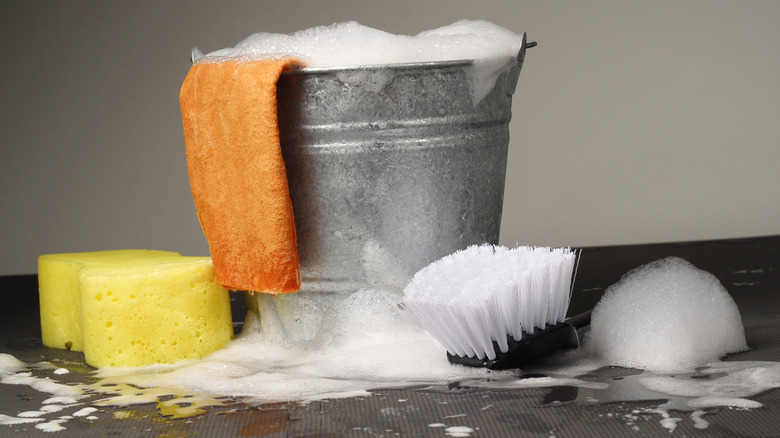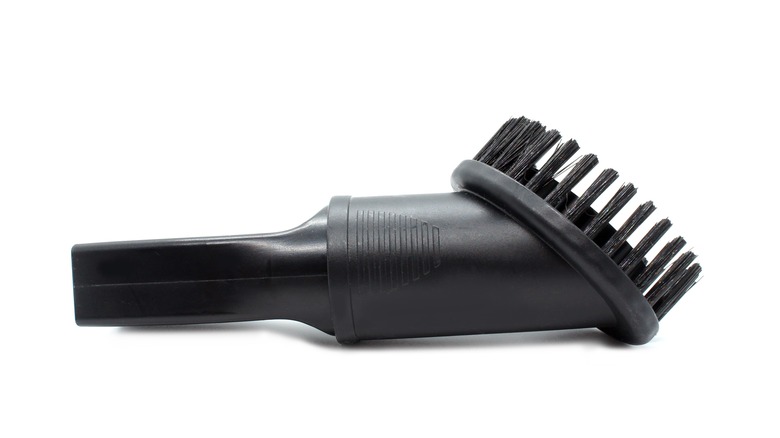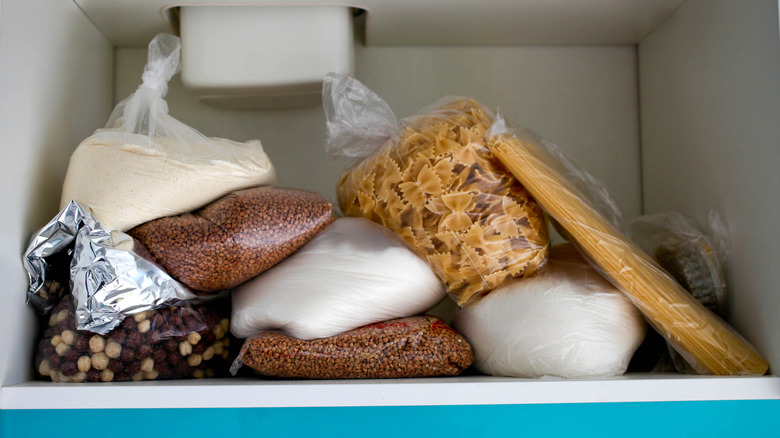Mistakes To Avoid When Deep Cleaning Your Kitchen Cabinets
We may receive a commission on purchases made from links.
There's nothing like the feel and look of a sparkling clean kitchen. It's where we prepare food, entertain guests, and do a lot of living. Knowing that every surface is sanitized and safe for food is reassuring and, to achieve that, even our cabinets need a deep clean every once in a while. Because this is such a frequently used space, it's important to avoid common mistakes that can lead to an unsanitary environment — especially since our kitchens and cabinets can house some of the highest amounts of bacteria in our homes.
However shocking it may seem, studies have shown that our spice cabinets are actually a hot spot for bacteria that causes food-borne illnesses to accumulate. If you're like most home chefs who constantly reach in and out of your cabinets while cooking, then the many jars and bottles can be the most germ-ridden areas in our kitchens. The constant handling and exposure to bacteria make them prone to germs, mold, and other harmful contaminants. Not to mention, the spice cabinet and other cabinets can often go unnoticed during our average cleaning routine because we can simply close the doors.
Check out these common mistakes to avoid when deep cleaning your kitchen cabinets. There are specific products to use and others to skip, and more tips and tricks for ensuring a clean and safe environment in your kitchen. Whether you're starting from scratch or aiming to refresh your cleaning routine, these tips will help you save time and money along the way.
Using abrasive products on painted cabinets
Using certain cleaning products on cabinets can be a tempting solution when you want to avoid excessive scrubbing to remove stains and grime. However, products that are too abrasive can seriously damage your cabinets, especially if they are painted. Products such as scouring pads, steel wool, and other tools can leave scratches on your paint or even deteriorate layers of varnish and top coat. Using common products like The Pink Stuff and Magic Erasers can cut back on scrubbing, but they also have the potential to damage layers of paint or strip away varnish after prolonged use. Opt for a microfiber cloth, dish soap, and warm water to tackle tough stains, or limit the use of abrasive cleaners to only every once in a while, being extra careful not to use too much pressure. You'd be surprised by how quickly a strong product can wear down layers of paint.
When shopping for products, remember there are different types of abrasive cleaners that are often hailed as powerful scrubbers: dry powders, liquid cleaners, scrubbing tools, and disinfectants. Powders and pastes often contain minerals such as calcite, feldspar, quartz, and silica, whereas tools usually have coarse materials that require lots of friction and scrubbing action. Liquid cleaners are similar to powders, but the intensity of the minerals is toned down. Although the liquids are often gentler, they can still be harsh on certain surfaces. These products vary; however, they essentially all have small rough particles that are great for lifting stains and breaking down grime, but can wreak havoc on smooth, soft surfaces.
Not using shelf liners
Kitchen cabinets are the perfect places for spilled food, grease, and dust to gather and go unnoticed. If it's behind a closed door or not at eye level, we tend to miss certain problem areas. Simply installing shelf liners can seriously cut back on the amount of grime in your cabinets and give them an easy, but attractive, upgrade. Stains can't absorb into the cabinets if a protective layer is covering the area.
Various kinds of liners are available, including vinyl, rubber, and cork, meaning you can be particular when choosing the look you want and how much to spend. Vinyl and rubber liners are durable and will easily protect your cabinets from scratches, stains, and spills. A damp cloth with some antibacterial spray will make easy work out of most of the stains or spills that occur on these liners.
For large messes, for example, if a jar of peanut butter cracks open, shelf liners will also make clean-up easy. Remove the liner completely, rinse it off in the sink, or simply replace the affordable liner and turn a big mess into an easy project. On top of function, the liners can be decorative and add a little something to your decor as well. You can easily add a pop of color or a nice design that's changeable and affordable. For example, cork liners can give your kitchen a unique and natural look, while extending the life of the cabinets. Cork is also a cushion between your cabinets and glassware, which means fewer chips and cracks as well.
Skipping over nooks and crannies
As you prepare to tackle your kitchen cabinets, it's all too tempting to skip over those minor nooks and crannies. You might figure if these areas are difficult to reach then they're not noticeable and likely aren't attracting much dirt. Whether you're trying to save time or simply don't think it's important, neglecting these hidden areas will only create a bigger cleaning job down the line. Dirt, dust, and grime are usually made up of small particles that can and will accumulate in these hard-to-reach areas that are often overlooked. The bad news is that they are the ideal breeding ground for bacteria and mold, with little light and airflow in the back corners, there's not much to deter buildup. Over time, these small nooks and crannies can cause unpleasant odors to develop and prevent your kitchen from feeling truly clean.
For a sparkling and pristine kitchen, it's essential to occasionally commit and give some special care and attention to those smaller areas. Once or twice a year, you might want to use an old toothbrush or another small bristle brush to really clear out these pesky spots. A set like OXO Good Grips Brushes, or something similar, will make the job easier. Be sure to reach into the corners, even if they're dark and unused. Don't forget to tackle the space around the hinges that can have grease on them and attract dust. Also, don't neglect the tops of your cabinets or underneath them. These areas might not be very noticeable, but the dust and grime will undoubtedly cluster there. Begin by scraping out dirt and dust, and then sanitize after for good measure.
Not using a degreaser
If you're cooking in your kitchen, then the cabinets are bound to accumulate a certain amount of grease and dust. Every time you cook, heat, or fry food, particles are released into the air and eventually settle on the various surfaces around your kitchen. Any type of fat, such as cooking oil or animal fat, can also create a lot of unpleasant splatter that will settle in the most unlikely places. Even with the use of a cooking vent over your stove or a grease screen, as time passes, certain amounts of debris will escape and fly around your kitchen. The steam and heat that occurs while cooking will rise and also spread grease on the tops of your cabinets, over time creating a major cleaning project. A sticky buildup of grease will also attract dust and other dirt, which can become a layer of grime covering your kitchen from top to bottom. The combo of grease and dirt will become harder to clear away with typical cleaning products.
To tackle this buildup on your cabinets, you should opt for a degreasing product that's designed specifically for tough kitchen stains. Products like Krud Kutter Kitchen Degreaser, Simple Green Heavy Duty Cleaner, and Goo Gone Kitchen Degreaser are all excellent options. These products are specifically formulated to dissolve and cut through stubborn grease buildup with minimal scrubbing, making it easy to restore your cabinets to their former glory. Be sure to follow the instructions on the label carefully and use the products in a well-ventilated area. Begin with a degreaser and take some of the guesswork out of your cleaning project.
Not adding your cabinets to your weekly cleaning routine
Your kitchen cabinets house some of the most important items in your home, such as food products, kitchenware, and more. It's essential to keep these areas clean and free of bacteria to avoid ingesting anything unhealthy, and one way to do this is to add these surfaces to your regular cleaning routine. Cabinets are high-traffic areas in any home, meaning you can expect frequent spills, splatters, and stains. By giving your cabinets a quick clean every couple of weeks, you can avoid using super overwhelming cleaning projects down the line. Frequent and quick cleanings will give your kitchen an overall sparkling feel that will last between big jobs.
In addition to freshening up the exterior of your cabinets every so often, it's also important to toss any unused or old items that can gather inside them. A crowded cabinet is not only difficult to keep organized and clean, but items can be pushed to the back where they go unnoticed and expire. This means wasting time and money replacing those products. Make a note to scan your shelves each week on trash day and toss anything that has expired. Another tip is to bring items that need to be used to the front where they won't be forgotten. After clearing your shelves, it will be easier to remove stains. To make the job even simpler, consider using quick and easy DIY all-purpose cleaners. Common products such as vinegar, baking soda, and dish soap can cut through stains and keep your cabinets immaculate without purchasing expensive or toxic cleaners.
Using your sponge to clean surfaces in your kitchen
It's the end of a long week, you finish the dishes, and you decide it's probably a good idea to give your kitchen cabinets a spruce as well. You might be tempted to snatch that sponge up and start scrubbing. However, this common cleaning tool could be spreading around more germs and bacteria than removing them. The unfortunate truth is that your average kitchen sponge contains more bacteria than any other surface in your home, including your bathroom. Studies have shown that sponges can harbor over 350 different types of bacteria, with millions of bacteria per square inch (via Blueland). That much bacteria near your food and eating utensils is a recipe for disaster.
Despite attempts to sanitize and clean sponges, it's nearly impossible to remove all of the bacteria found in them. The damp and porous environment is a breeding ground for germs and more. The USDA recommends sanitizing your sponges in bleach and water for at least five minutes regularly to kill bacteria. If you're tossing your sponge into the dishwasher to sanitize it, be sure that the setting is on the hottest cycle. Still, these efforts to keep a sponge clean are not fool-proof. For a truly deep clean, consider more sanitary options, such as disposable wipes or paper towels. A microfiber washcloth is an even better option that is sustainable and less expensive because you can toss them in the washer after each use. Microfiber cloths dry much faster than other materials, which limits opportunities for bacteria to grow in the first place.
Not using an antibacterial cleaner
Almost 10% of food-borne illnesses can be traced back to home kitchens, according to Cleveland Clinic. The harmful bacterias that can cause food poisoning and more are nearly impossible to detect with the naked eye, meaning your kitchen could unknowingly pose a serious threat. Using antibacterial cleaner is one simple and easy way to ensure that where you prepare and store your food is flawless. Studies have revealed that it's easier than you might think to cross-contaminate in your own kitchen while preparing a meal. Reaching for a cutting board, a knife, or a needed spice in the midst of a busy dinner prep can quickly spread germs. Without proper cleaning products and tools, bacteria can thrive in your kitchen cabinets and cause illness and discomfort.
Scrubbing with typical sprays and cleaners can clear away most types of bacteria from your kitchen cabinets. However, even small lingering traces of germs can cause food poisoning. Begin by clearing away dirt and dust that can harbor other germs, but be sure to apply an even layer of antibacterial spray to get an extra deep clean. Another tip is to pay special attention to those high-traffic surfaces, such as cabinets and drawer handles, where small particles can get stuck in crevices and gaps. Consider using an antibacterial spray as part of your daily cleaning routine, but be sure to go a little deeper after preparing meat and poultry, seafood, fresh fruits and veggies, and raw dairy products, which frequently carry bacteria.
Using excessive amounts of water
As you prepare to take on the job of deep cleaning your kitchen cabinets, you might want to rethink that bucket full of water. Scrubbing the inside of your cabinets with some soapy water and a brush is a simple solution; however, a common mistake is using excessive amounts of water. A splash of warm water can break down a lot of stains and spills, but it can also create a prime environment for mold and mildew to grow. According to FEMA, mold and mildew can begin to form in as little as 24 hours under the right circumstances. Once these harmful fungi start, they can be incredibly difficult to remove and dangerous if left to grow.
Applying too much water makes it easy for moisture to seep and drip into tiny crevices and cracks in your cabinets, where it can remain for hours or even days. This moisture is the beginning of mold and mildew, especially if your kitchen is already humid or poorly ventilated. Cabinets are typically closed up, which means there's little airflow to dry the moisture and no natural light. If left untreated, the mold and mildew can spread throughout your cabinets, causing unpleasant odors and eventually damaging the structure of the wood. Eventually, the mold spores are released into the air and can travel through the rest of your home. If you are exposed to mold or mildew for a prolonged amount of time, it can cause skin and eye irritation. Breathing it in can also cause long-term respiratory issues or aggravate allergies.
Not using your vacuum to speed up the job
Deep cleaning cabinets can be a tedious project, especially when you're chasing down crumbs and debris that seem to have a life of their own, and can attract insects and other pests if left behind. While wiping cabinets down can be effective, using a vacuum cleaner can be a game changer. Not only will the job go faster, but you can easily clean those back corners and hard-to-reach areas that attract dust.
The trick is to skip the regular vacuum nozzles. Find a small attachment that has bristles on the end of your hose, such as this five-piece Soft Bristle Round Brush Vacuum Attachment Set available on Amazon. The bristles will be able to get into all the nooks and crannies, removing dirt and grime that you didn't even know was there. Make a note to hit your cabinets with a vacuum before the colder winter months. According to PestWorld.org, approximately 20 million homes in the United States have some type of rodent in the cooler months when they begin to retreat from the weather and search for easy food supplies. Vacuuming can easily cut back on crumbs that attract those pests.
Cleaning around the items in your cabinet
The lazy man works the hardest, and this phrase couldn't be more accurate when it comes to deep cleaning your kitchen. Although it may seem like a good idea to simply clean around the items in your cabinets, this will undoubtedly make the project more time-consuming in the long run. Every once in a while, it's worth the extra effort to remove everything from the cabinets and clean deeply. This is also a prime opportunity to sort through and toss any expired or unwanted items to keep your cabinets organized and clutter-free — as well as clean.
When you attempt to tidy up around the items, such as food boxes, plates, and glasses, you're essentially leaving dirt and grime untouched. Over time, this buildup can become more difficult to clear up, and you may find yourself scrubbing harder and longer than if you had just taken the time to move the items and clean thoroughly in the first place.
